Triathlon Running
The Final Chapter
The triathlon running leg is invariably the toughest of the three! It is where you 'empty your tank' (as you can see from the picture of my wife, Jan)!
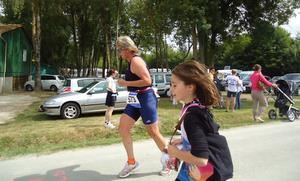
The problem with this stage is that, if you haven't judged the swim and bike stages correctly, the tank can empty a lot earlier than you want it to! I have found this to my cost on several occasions.
However, there are ways to avoid this happening. It is very easy to get carried away on race day and, on the gun, go out too fast on the swim or get involved in a battle on the bike. It is vital to go into the race with a definite pacing plan and stick to it.
This involves not only a strong mental attitude during the race but also effective planning during your triathlon running training. Maybe you have friends in a running club that are churning out many tens of miles a week training. Not only is that not feasible if you are training for three sports, but it is not necessary.
One of the benefits of triathlon training is that you are training for three events.
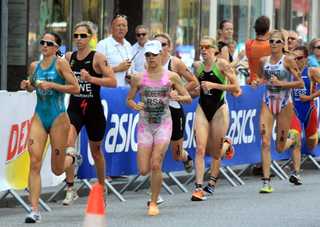
Training for the triathlon is a form of 'cross training'. Cross-training in sports refers to the combining of exercises to work various parts of the body.
In other words, you can have had a good swim training session on one day and a long run the next whereby you are using totally different muscle groups.
This, in turn, means that the cardio vascular benefits achieved in your swimming and bike training are carried over to your triathlon running training. You simply do not need to run anywhere near as far as your running mates to achieve similar results in fitness.
Having established that quantity is not always quality, we need to decide on the most effective form of triathlon running training in a limited amount of time.
My training has changed a lot over recent years. I used to have set runs where I was always trying to beat my 'record'. I had splits by just about every tree and it was eyeballs out most of the time. That is most of the time when I wasn't injured!
Nowadays, my focus has changed entirely. If we look at triathlon running training for, at the most, three times a week, it is important that we get the most out of the sessions. The training can be based very much around the type of training you may be doing on the bike.
Hill training is a great way of strengthening the legs. This can take the form of interval work, just as on the bike, where you run the same hill recovering on the way back down.
Hill training can serve two purposes. Firstly, you are gaining the obvious fitness benefits. Secondly, and almost as importantly, you are learning how to run hills.
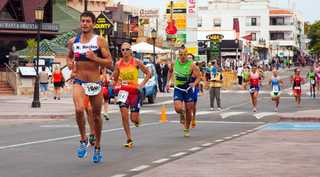
I always remember reading an article by the great British runner, Charlie Spedding, the English record holder for the marathon, a winner of the London Marathon, and the last British athlete, male or female, to win a medal in the Olympic Marathon.
In this article he said that you must learn to 'love hills'! How many times have you run with someone who says 'not another hill' or 'I can't do hills'? Turn hills into a positive. They are always going to be there so make the most of them. With a positive approach to a hill it is surprising how many runners you can pass. Once past them you probably won't see them again.
On a particularly long hill break it down into sections. Don't look at the hill as a whole but maybe at the first lamppost 200 metres away, then a gateway, then a parked car etc. This way the hill doesn't seem so daunting and also seems to pass quicker. Try to keep the pressure on over the top of the hill for a short distance rather than losing your advantage gained by easing off.
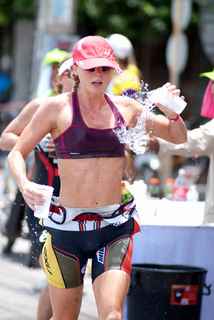
These hill sessions shouldn't be done until you have a reasonable level of fitness. This can be achieved by having at least one, preferably two, long aerobic runs per week.
The distance run will depend on your current level of fitness but your aim will be to manage one hour comfortably. Try to run slightly faster than you would normally do but without going into oxygen debt too early.
We mentioned fartlek training during your cycle workouts. Fartlek training was devised in Sweden and means 'speed play' in Swedish. It is an unstructured type of interval training developing both aerobic and anaerobic capacities.
A typical session could incorporate a warm up, hard speed for 5-6 minutes, a short walk, several intervals, some hills, in other words whatever you feel comfortable with. I've even included press ups and sit ups.
Try, also, to include a bike/run transition at least once a fortnight. This could be done after the long bike session. get used to getting off the bike, out of your cycle shoes and on with your triathlon running shoes as quickly as possible.
Then straight into the run which you will find quite strange for the first few times. You will have been using your cycle muscle and all of a sudden your running muscles are coming into action! Run for about twenty minutes just to get well into your triathlon running which you will find very different from just going out for a run.
After a few times you will get used to, and faster at, this transition and it will be second nature by the time you get to the race.
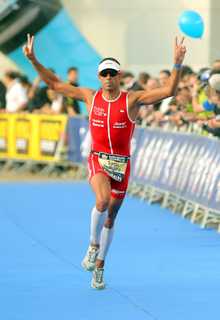
It is difficult to tell someone exactly what running technique to use because of so many physiological differences. However, if there is one factor that everyone should concentrate on it is that of relaxation.
I used to teach Physical Education and would have lessons where I would really work on relaxation. I would tell the children to watch the slow motion footage of sprinters shown on television.
The same principles can apply to triathletes. Relax at all possible times and I find, particularly in the run, if I can relax my facial muscles the rest of the body tends to follow.
With sufficient and correct training you will go into your races full of confidence. What an important factor that is towards a successful triathlon!
Return from triathlon running to Triathlon Club home page
Membership of the Triathlon Club is FREE!
Please join us by signing up for our newsletter which will tell you each month about information we have added to the website!